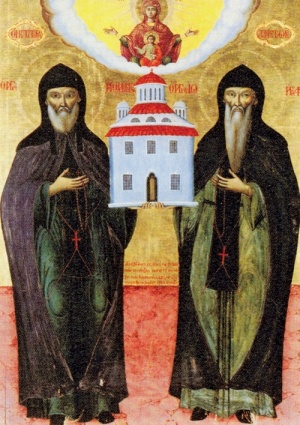Difference between revisions of "Great Meteoron Monastery (Meteora)"
m (added link; spacing) |
m (add icon) |
||
| Line 1: | Line 1: | ||
{{stub}} | {{stub}} | ||
| − | The '''Great Meteoron Monastery''', also Megalo Meteoro and Metamophosis, is the main [[monastery]] in the [[Meteora]] complex in Greece. The community is also known as '''Monastery of the Transfiguration'''. It was founded by the [[monk]] Athanasius Koinovitis in the mid-fourteenth century. | + | [[Image:Agioi-athnasios-kai-ioasaf-oi-meteoritai.jpg|right|thumb|Saints Athanasios of Meteora (1302-1380) and Ioasaph of Meteora (1349/50-1422/23).]] |
| + | The '''Great Meteoron Monastery''', also Megalo Meteoro and Metamophosis, is the main [[monastery]] in the [[Meteora]] complex in Greece. The community is also known as '''Monastery of the Transfiguration'''. It was founded by the [[monk]] [[Athanasios of Meteora|Athanasius Koinovitis]] in the mid-fourteenth century. | ||
==History== | ==History== | ||
Athanasius began the [[monasticism|monastic]] community on the Platys Lithos, or Broad Rock, a few years after his arrival in the Meteora, which was the highest pinnacle. In 1356, the Serbian Emperor Symeon Uros endowed the community with funds to build the [[Katholikon]] of the [[Transfiguration]] and expanded the monastery. The katholikon has a twelve-sided dome that is 78 feet (24 meters) in height and a series of frescos that depict persecution of Christians by the Romans. The frescos were done by Theophanis. | Athanasius began the [[monasticism|monastic]] community on the Platys Lithos, or Broad Rock, a few years after his arrival in the Meteora, which was the highest pinnacle. In 1356, the Serbian Emperor Symeon Uros endowed the community with funds to build the [[Katholikon]] of the [[Transfiguration]] and expanded the monastery. The katholikon has a twelve-sided dome that is 78 feet (24 meters) in height and a series of frescos that depict persecution of Christians by the Romans. The frescos were done by Theophanis. | ||
| − | About 1373, John Uros, the son of Symeon Uros, retired to the Grand Meteoron as the monk Ioasaph. He succeeded Athanasius on his death in 1383 and continued the expansion of monastery and the church until his death in 1422. | + | About 1373, John Uros, the son of Symeon Uros, retired to the Grand Meteoron as the monk [[Ioasaph of Meteora|Ioasaph]]. He succeeded Athanasius on his death in 1383 and continued the expansion of monastery and the church until his death in 1422. |
==External link== | ==External link== | ||
Latest revision as of 13:42, April 9, 2011
The Great Meteoron Monastery, also Megalo Meteoro and Metamophosis, is the main monastery in the Meteora complex in Greece. The community is also known as Monastery of the Transfiguration. It was founded by the monk Athanasius Koinovitis in the mid-fourteenth century.
History
Athanasius began the monastic community on the Platys Lithos, or Broad Rock, a few years after his arrival in the Meteora, which was the highest pinnacle. In 1356, the Serbian Emperor Symeon Uros endowed the community with funds to build the Katholikon of the Transfiguration and expanded the monastery. The katholikon has a twelve-sided dome that is 78 feet (24 meters) in height and a series of frescos that depict persecution of Christians by the Romans. The frescos were done by Theophanis.
About 1373, John Uros, the son of Symeon Uros, retired to the Grand Meteoron as the monk Ioasaph. He succeeded Athanasius on his death in 1383 and continued the expansion of monastery and the church until his death in 1422.
